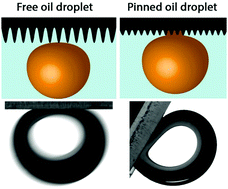Influence of long-range forces and capillarity on the function of underwater superoleophobic wrinkled surfaces†
Abstract
Underwater superoleophobic surfaces can be considered a particular type of lubricant-infused surface, that have anti-fouling properties by virtue of a trapped water layer that repels oils. However, as their function relies on a water layer being trapped in the surface roughness, it is crucial to understand the factors that determine the layer stability. In this work, the forces that are responsible for the stability of thin liquid films within structured surfaces were quantified, and the conclusions were tested against the performance of wrinkled surfaces as underwater superoleophobic coatings. Here, the system studied was a family of wrinkled surfaces made of hydrophilic poly(4-vinylpyridine) (P4VP), whereby the wrinkle width could be controllably tuned in the range 90 nm to 8000 nm. The van der Waals free energy was quantified and the capillary forces trapping water in the surface micro- and nano-wrinkle structure were estimated. P4VP surfaces with micro-scale wrinkles had underwater superoleophobic properties, and low adhesion to different oils with droplet roll-off angle below 6° ± 1°. Despite the van der Waals free energy of the system pointing to the dewetting of a water film under oil on top of a smooth P4VP film, the wrinkled structure is sufficient to induce a Cassie state with a trapped water layer. The micro-scale wrinkles (average width 4–12 μm) were found to be particularly effective in the trapping of the water in a Cassie non-adhesive state. The P4VP wrinkled surfaces are superamphiphobic, as when they were first infused with oil, and then exposed to a droplet of water under oil, they exhibited superhydrophobic behavior. The P4VP wrinkles have the additional useful feature of being transparent underwater, which makes them useful candidates for the protection of underwater cameras and sensors.



 Please wait while we load your content...
Please wait while we load your content...